Connection Element
a technology of connecting elements and elements, applied in the field of connecting elements, can solve the problems of feared damage to wiper rubber, and achieve the effect of increasing surface pressure and small additional costs
- Summary
- Abstract
- Description
- Claims
- Application Information
AI Technical Summary
Benefits of technology
Problems solved by technology
Method used
Image
Examples
Embodiment Construction
[0023]A wiper blade 10 having a wiper rubber 12 has two spring bars 14 which serve as loadbearing elements and are inserted into lateral longitudinal grooves of the wiper rubber 12. A connection element 16 which has a base part 18 and side walls 24 which are formed integrally on the latter is mounted on the wiper blade 10. Claws 22 which surround the spring bars 14 at the parts which protrude from the wiper rubber 12 are formed integrally on the base part 18 on the longitudinal sides.
[0024]The side walls 24 are connected to one another by a joint hub 26 which, together with a joint pin (not shown) of the wiper arm, forms a joint with a joint axis 27. In principle, the method of operation of the joint hub 26 and joint pin can be reversed, with the result that the side walls 24 are connected to one another by a joint pin and a joint hub 26 is provided on the wiper arm.
[0025]A clamping part 28 is mounted pivotably via bearing channels 30 in the side parts 24 parallel to the joint hub 2...
PUM
 Login to View More
Login to View More Abstract
Description
Claims
Application Information
 Login to View More
Login to View More - R&D
- Intellectual Property
- Life Sciences
- Materials
- Tech Scout
- Unparalleled Data Quality
- Higher Quality Content
- 60% Fewer Hallucinations
Browse by: Latest US Patents, China's latest patents, Technical Efficacy Thesaurus, Application Domain, Technology Topic, Popular Technical Reports.
© 2025 PatSnap. All rights reserved.Legal|Privacy policy|Modern Slavery Act Transparency Statement|Sitemap|About US| Contact US: help@patsnap.com



